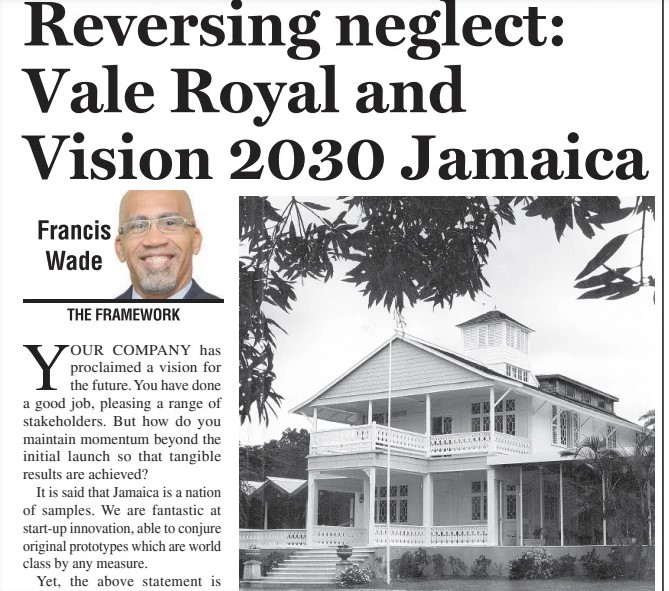Your organization has crafted a vision for the future, winning the approval of a wide array of stakeholders. But how do you keep that momentum alive beyond the initial excitement and actually deliver results?
Jamaica is known for its creativity, especially when it comes to innovation. We excel at producing world-class prototypes and ideas.
However, that reputation also highlights a significant gap: a lack of emphasis on follow-through and upkeep. There’s an old saying: hire a Jamaican for innovation, a Trinidadian to launch it with flair, and a Bajan to handle the day-to-day operations.
Consider Vale Royal as an example. Recently, a viral internet post depicted the state of this historic 1694 property, once the official residence of past Prime Ministers. Despite the Jamaican coat of arms adorning it, the image revealed a dilapidated building.
The reaction was swift and unanimous: shock and disappointment. This was hardly a proud moment for the nation. Clearly, some part of the government process had failed, leaving an eyesore in its wake. The only consolation? The neglected building is set back from the road, slightly out of public view.
What lessons can this teach us about managing grand aspirations like Vision 2030 Jamaica, and how can you apply these insights to ensure your organization’s vision doesn’t face the same fate?
Visions Are Hard to Maintain
Unlike physical objects, a vision is built from fragments of imagination. While it’s often captured in written form, what truly matters is the resonance it finds within people.
A compelling vision takes root in the hearts and minds of those who see themselves in it. It inspires them, evoking strong emotions and a shared sense of purpose toward a future they want to make real.
Yet, creating a tangible product is far easier than inspiring others to envision a brighter future. Those who do this effectively—figures like Marcus Garvey, Martin Luther King Jr., and Nelson Mandela—are rightfully revered.
Sustaining a vision over time is even harder than maintaining a physical structure. Today, both Vale Royal and Vision 2030 Jamaica are in need of revitalization. Though their restoration processes would be different, neither is beyond hope.
Now, think of your own organization. Are stakeholders genuinely motivated by your vision? Has its impact faded? Can you rekindle the energy it once generated?
Ordinary Efforts Won’t Achieve Extraordinary Visions
Perhaps a common oversight by those managing both Vale Royal and Vision 2030 Jamaica was the assumption that regular, routine efforts could somehow produce remarkable, transformative outcomes.
This isn’t just a government issue; the same challenge exists in any organization. Some employees are skilled at keeping day-to-day operations steady. As author Robert Pirsig (in *Zen and the Art of Motorcycle Maintenance*) puts it, they preserve “static quality.” They are essential—but they are not visionaries.
For breakthrough change, you need people who drive “dynamic quality,” those who push for improvement and innovation.
Pirsig argues that both roles are essential, but they must be balanced. A possible misstep with Vision 2030 Jamaica was the reliance on government staff focused on “static quality” to also execute and govern a forward-looking vision.
As a result, while Jamaica started Vision 2030 with momentum, the progress has slowed. To avoid this pitfall, your organization must institutionalize the management and execution of its vision, creating a structure that ensures enduring commitment.
This approach, though it may seem new, draws on a proven success story.
Introducing a Vision-Oriented Oversight Committee
Jamaica’s significant reduction in its debt-to-GDP ratio has been celebrated worldwide. This accomplishment was thanks to a bipartisan, long-term effort that drew upon disciplined oversight from the private sector, trade unions, and civil society.
What if your organization established a similar framework—a “Vision-Oriented Oversight Committee” (VPOC)? This committee would serve as a vision-focused equivalent to Jamaica’s Economic Programme Oversight Committee (EPOC), actively balancing both static and dynamic qualities to ensure sustained progress. In some cases, a board could serve this function.
This idea could be the key to Vision 2030 Jamaica’s success. Without a VPOC, the likelihood of achieving Jamaica’s aspiration to become “the place of choice” may continue to diminish over the next six years, potentially jeopardizing one of our most ambitious goals since independence.

